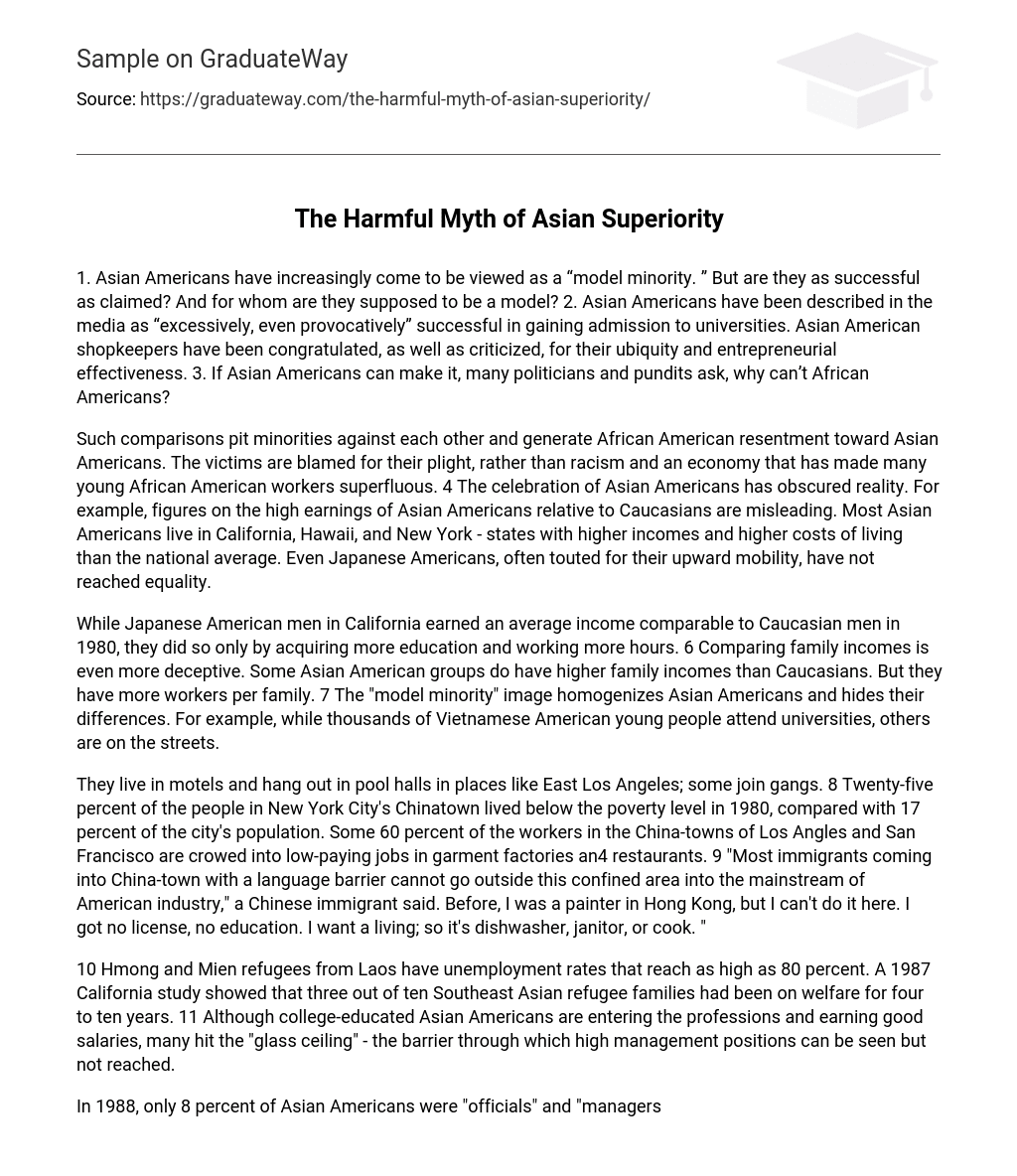1. Asian Americans have increasingly come to be viewed as a “model minority. ” But are they as successful as claimed? And for whom are they supposed to be a model? 2. Asian Americans have been described in the media as “excessively, even provocatively” successful in gaining admission to universities. Asian American shopkeepers have been congratulated, as well as criticized, for their ubiquity and entrepreneurial effectiveness. 3. If Asian Americans can make it, many politicians and pundits ask, why can’t African Americans?
Such comparisons pit minorities against each other and generate African American resentment toward Asian Americans. The victims are blamed for their plight, rather than racism and an economy that has made many young African American workers superfluous. 4 The celebration of Asian Americans has obscured reality. For example, figures on the high earnings of Asian Americans relative to Caucasians are misleading. Most Asian Americans live in California, Hawaii, and New York – states with higher incomes and higher costs of living than the national average. Even Japanese Americans, often touted for their upward mobility, have not reached equality.
While Japanese American men in California earned an average income comparable to Caucasian men in 1980, they did so only by acquiring more education and working more hours. 6 Comparing family incomes is even more deceptive. Some Asian American groups do have higher family incomes than Caucasians. But they have more workers per family. 7 The “model minority” image homogenizes Asian Americans and hides their differences. For example, while thousands of Vietnamese American young people attend universities, others are on the streets.
They live in motels and hang out in pool halls in places like East Los Angeles; some join gangs. 8 Twenty-five percent of the people in New York City’s Chinatown lived below the poverty level in 1980, compared with 17 percent of the city’s population. Some 60 percent of the workers in the China-towns of Los Angles and San Francisco are crowed into low-paying jobs in garment factories an4 restaurants. 9 “Most immigrants coming into China-town with a language barrier cannot go outside this confined area into the mainstream of American industry,” a Chinese immigrant said. Before, I was a painter in Hong Kong, but I can’t do it here. I got no license, no education. I want a living; so it’s dishwasher, janitor, or cook. “
10 Hmong and Mien refugees from Laos have unemployment rates that reach as high as 80 percent. A 1987 California study showed that three out of ten Southeast Asian refugee families had been on welfare for four to ten years. 11 Although college-educated Asian Americans are entering the professions and earning good salaries, many hit the “glass ceiling” – the barrier through which high management positions can be seen but not reached.
In 1988, only 8 percent of Asian Americans were “officials” and “managers,” compared with 12 percent for all groups. 12 Finally, the triumph of Korean immigrants has been exaggerated. In 1988, Koreans in the New York metropolitan area earned only 68 percent of the median income of non-Asians. More than three-quarters of Korean greengrocers, those so-called paragons of bootstrap entrepreneurialism, came to America with a college education. Engineers, teachers, or administrators while in Korea, they became shopkeepers after their arrival. For many of them, the greengrocery represents dashed dreams, a step downward in status.
3 For all their hard workers and long hours, most Korean shopkeepers actually earn very much: $17, 000 to $35, 000 a year, usually representing the income from the labor of an entire family. 14 But most Korean immigrants do not become shopkeepers. Instead, many find themselves trapped as clerks in grocery stores, service workers in restaurants, seamstresses in garment factories, and janitors in hotels. 15 Most Asian Americans know their “success” is largely a myth. They also see how the celebration of Asian Americans as a “model minority” perpetuates their inequality and exacerbates relations between them and African Americans.
Tasks:
1. Make an outline of this essay.
2. Paraphrase the following part.
Original
1. Asian Americans have increasingly come to be viewed as a “model minority.” But are they as successful as claimed? And for whom are they supposed to be a model?
2. Asian Americans have been described in the media as “excessively, even provocatively” successful in gaining admission to universities. Asian American shopkeepers have been congratulated, as well as criticized, for their ubiquity and entrepreneurial effectiveness.
3. Write a summary of the easy.
4. With Takaki’s easy, list the issues that you can explore?
5. Evaluate the easy (appropriateness, credibility and consistency and completeness).
6. Explain the organization of the essay.
7. Which sentences do you think are particularly striking and effective and you would like o emulate later in your writings?





